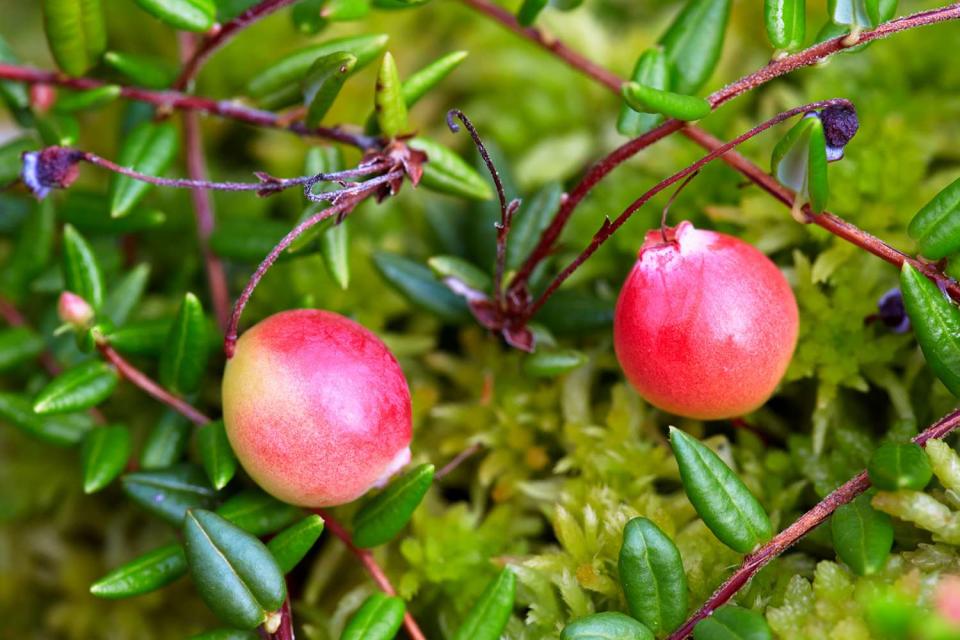How to Plant and Grow Cranberries
Here's what you need to know to grow cranberry plants in your backyard.

Klaus Honal / Getty Images
Cranberries often are featured as part of Thanksgiving feasts and other festive wintertime meals. Imagine how much more special your cranberry sauce would be when made with homegrown cranberries. These tart berries aren’t difficult to grow if you have the right conditions. There lies the challenge. Cranberry plants are low-growing, woody, vine-like shrubs that need acidic soil, cool temperatures, and lots of moisture.
“These are likely NOT the conditions that most home gardeners would have,” says Hilary Sandler, Director of University of Massachusetts Cranberry Station. However, with a bit of preparation and some elbow grease, you can create a bed for growing these tasty, healthful berries right in your own backyard.
:
A Bit About Cranberries
The American cranberry (Vaccinium macrocarpon) is native to temperate regions of northeastern and central United States and southern Canada (USDA Hardiness Zones 2-6). It belongs to the same plant family as blueberries, azaleas, and rhododendrons, and like these species, cranberries require an acidic soil to thrive.
Cranberry plants form mats about eight to 18 inches tall with small dark evergreen leaves. Stems grow horizontally six to eight feet, developing upright shoots along their length that produce clusters of small pink flowers followed by bright red fruit—as long as there are pollinators around. “Cranberries need pollination to produce decent sized fruit,” says Sandler. The berries are harvested in the fall after they turn bright red.
When to Plant Cranberries
Cranberries are usually planted in spring when nights are still cool but not so cold as to cause damage to young plants. Get them in before the weather gets too warm so that new roots develop before summer. In warmer regions, they can be planted in the fall.
How to Plant Cranberries
It takes a good bit of space for cranberry fruit production to be worthwhile: you’ll need a plot of about four feet square to produce a single pound of cranberries. And unless you have a sandy bog in your backyard, you will probably need to put some effort into preparing a dedicated bed for your cranberries.
Whether you create a special planting bed or use an existing area of the yard, do a soil test first. If the pH is above 5, add sulfur to acidify it. You can also add peat moss. (It’s a good idea to retest the soil every two or three years to be sure the pH is still within range.) It's important to test the pH of your water as well. If it’s alkaline, it will continuously raise the soil pH, making it difficult to grow cranberries. It’s worth finding this out before you plant.
If you don’t have a sandy bog in your backyard, you can create a dedicated bed for your cranberries, either by constructing raised beds or by digging out an area to a depth of about 10 inches and removing the native soil. Fill the raised or dug-out bed with a six-inch layer of peat moss supplemented with a fertilizer for acidic plants.
Wet the peat moss, allowing it to soak up moisture slowly, and turning it every half hour or so. This step may take a few hours. Once the peat moss is evenly moist, top it with four inches of coarse sand. Plant your cranberry plants, spacing them about two to three feet apart in the bed and water well. Set them at the same depth as they were growing in the nursery pot. Be sure to keep the beds evenly moist, watering every few days as needed.
Cranberry Care Tips
Give your newly planted cranberry plants the care they need, and you can expect your first harvest two to three years after planting. “Cranberries typically take three to five years to reach what we would consider full production,” says Sandler.
Light
Cranberries do best in full sun. In warmer regions, they benefit from a little afternoon shade.
Soil and Water
Cranberries are bog plants with roots that only extend into the upper six inches or so of soil. While consistent moisture is important, they don’t like “wet feet,” so the soil needs to be well drained. (Commercial cranberry growers often flood their fields in the fall to facilitate mechanical harvesting, but cranberries do not grow in water.) Adding organic matter can help improve less-than-perfect drainage.
Temperature
To produce a crop. your cranberry plants need at least three months where temperatures fall between 32-45°F. If this isn't the case in your climate, you can still grow cranberries as an evergreen groundcover.
Fertilizer
Use a slow-release fertilizer supplemented with periodic applications of a liquid fertilizer such as Miracid for the first year after planting. Once the vines cover the planting area, cut back on fertilizing.
Pruning
“If [cranberries] are fertilized moderately, pruning could be once every three to five years,” says Sandler. She also notes that if you feed them too much nitrogen, “they will yield less fruit and need more frequent pruning.” The best time to prune cranberry plants is in late winter before new growth starts.
:
Types of Cranberries
According to the Cranberry Marketing Committee, more than 100 varieties of cranberries are grown in the U.S. For backyard gardeners who are “planning to harvest fruit, they may prefer native varieties such as ‘Early Blacks’ or ‘Howes’, which are traditional varieties grown here in Massachusetts,” says Sandler.
A variety discovered in 1852, 'Early Blacks' cranberries ripen in September, allowing them to be harvested before fall frosts. Though the berries are smaller, they have a sweeter flavor and bright red color.
Another older variety from 1843, 'Howes' fruit ripens about three weeks later than 'Early Blacks'. The large, firm berries are tart and store well.

